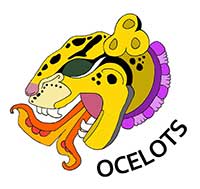OCELOTS Spring 2024 FMN: Implementing a module in tropical biology
Selected Modules
These are the selected modules for this Faculty Mentoring Network (FMN). During Spring 2024, participants will implement a module, or parts of modules, in two of their course meeting times. These modules cover a range of topics in tropical ecology, so please select the module that will fit best into your course curriculum. Click on individual links below, or access the OCELOTS library (https://www.learngala.com/catalog/libraries/ocelots).
- “A rainforest with a gold chain?” by U. Valdez, R. Arauco, and J. Gerson. https://www.learngala.com/cases/rainforest-with-a-gold-chain. The use of mercury in artisanal gold mining affects aquatic and terrestrial food webs in the Peruvian Amazon. Learn about bioaccumulation, explore data on mercury deposition in vegetation and how these connect to human health and socio-economic systems.
- “Functional trait-based restoration” by R. Ostertag and N. DiManno. https://www.learngala.com/cases/functional-trait-based-restoration. A hybrid restoration experiment in Hilo, Hawaiʻi, in an area of high biocultural conservation value, that address the ecological and philosophical issues involved in conducting restoration with a combination of native and introduced species.
- “High technology to measure forest carbon stocks” by C. Torres de Almeida. https://www.learngala.com/cases/remote-sensing-biomass. A case study on the estimation of aboveground biomass using advanced remote sensors (LiDAR and hyperspectral) in the Brazilian Amazon. Students explore remote sensing (RS) data and compare RS-based models to understand tropical carbon dynamics.
- “Plant-microbial mutualisms in canopy gap recovery” by L. A. McCulloch and J. Mora Sibaja. https://www.learngala.com/cases/treefalls-plant-microbes. This module uses tropical plant-soil microbial interactions in canopy gaps as a lens to better understand species interactions and disturbance ecology, while showing how scientists study these systems and enhancing students’ ability to interpret figures.
- “Vegetation Greening: A snapshot from the Andean Tropics” by X. Haro-Carrión, B. Berry, and L. Eggers. https://www.learngala.com/cases/tropical-vegetation-greening. This online module explores how satellite images are used to study vegetation greenness and, using Ecuador as an example, demonstrates how tropical vegetation experienced increased greenness between 1982 and 2010.
- “Wildlife crossings in Costa Rica” by M. Mooring, A. Cordero, and J. Ewing. https://www.learngala.com/cases/costa-rica-wildlife-crossings. In this case study, students are introduced to the effect of roads and highways on native animals. After learning about types of crossings and predicting animal usage, they examine data on the impacts of the crossings. These studies represent the first time in Central America that the effectiveness of wildlife crossings was tested to establish whether well-designed structures can contribute to wildlife-friendly roadways.
